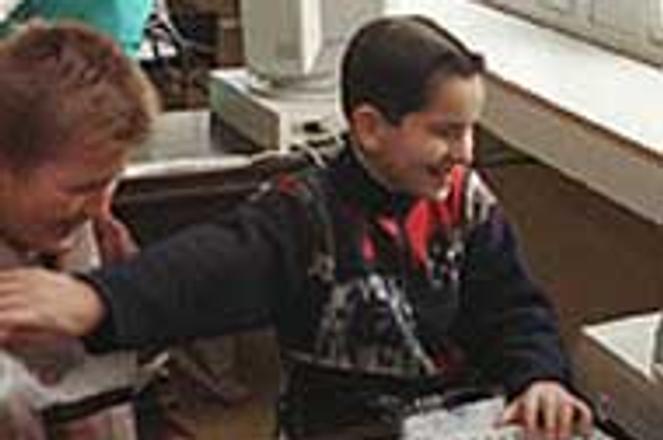Students in Košice learn the ins and outs of the Internet. But while Slovak schools are gaining greater Internet access, the national level of IT knowledge is still far behind what it is in western countries.photo: TASR
Gymnázium Juraja Hronca in Bratislava is something of an anomaly in the Slovak educational system - not only is the school connected to the Internet, its 50 computers available to the school's roughly 500 students have pervaded all areas of school activity, from research and word processing to extra-curricular activities.
During breaks between lessons, children flock to the school's three computer rooms to surf the web and e-mail their friends. In 1998 Slovakia won the International Information Olympics - with a team comprised of students mostly from Juraja Hronca.
But halfway around the world, Lyons Jr./Sr. High School in the US enjoys facilities far superior than those used at Jura Hronca. With two computer laboratories and a computer in every classroom, Lyons has approximately one computer for every 2.5 students. In addition, a design-drawing lab contains software worth $80,000 and soon a new multi-media room with high-tech projectors, cameras, microphones and speakers will open, enabling students to take classes and participate in workshops with other students and lecturers from all over the world.
The comparison illustrates a disturbing truth about the growing IT gap between Slovak schools and the West. While Lyons Jr./Sr. High may only be two or three years ahead of its Slovak counterpart, Jura Hronca represents the vanguard of information technology in Slovak education. Lyons, on the other hand, is an ordinary public school in a rural town of 5,000 in upstate New York. Most Slovak high schools the size of Lyons will have only a handful of computers with Internet access.
Currently only 10% of Slovak high schools and less than 1% of primary schools are on-line. But Slovak schools and community leaders say they realise the importance of training the country's younger generations and that they are now beginning to overcome barriers, such as their late start and tight budget, to turn the tide.
After almost doubling its expected budget for 2000, Project Infovek, a non-profit organisation of teachers and educational professionals, is more optimistic than ever about achieving its goal of getting every Slovak High School on-line by the year 2005. Last year, with the support of Education Minister Milan Ftáčnik, Infovek connected 100 high schools to the Internet. "Information Technology is an absolute priority for us," Ftáčnik told The Slovak Spectator on April 10. "In five years, Slovakia's current IT situation will be much improved."
Already some changes are visible in Slovak society as a whole. Recent polls revealed that Slovakia may not be as far behind the rest of Europe as some had claimed. At the beginning of April a survey by IDC, a division of the International Data Group, found that 20% of western Europeans were Internet users, almost a two-fold increase from the beginning of 1999. According to a survey by Taylor Nelson Sofres Factum in December last year, 12.7% of Slovaks were Internet-users, or slightly more than the Western European average just a year before.
As Slovakia transforms into a country where IT plays a vital role, young Slovak professionals and students are leading the way. While a new approach to IT teaching in Slovak education has ensured that the country's next generation will be increasingly computer literate, it is Slovaks in their 20's (the largest group of Internet users according to the TNSF survey) who, as a labour force, have acquired the computer skills to work in today's market.
Stanislav Fančovič, from the Human Resources firm Take-It, said that an Austrian firm contacted his company recently looking for an IT expert after being frustrated by the inability of their searches elsewhere to turn up even one qualified candidate.
"Not long after they contacted us we started a search and right away got 15 responses, which we narrowed down to eight," he said. "The Austrian firm couldn't believe that in Slovakia we had been able to find so many excellent, qualified people."
Fančovič added that a lot had changed over the past two years, as employees and firms have worked hard to catch up internationally. "Young candidates, especially those from universities, don't have problems with computer skills," he said. "You can find people here as qualified as in Western countries."
Although the number of Slovak Internet users rose only 3.7% over the past 16 months, the number of regular users may have doubled. According to Ivan Debnár, director of the search engine Zoznam, one of the most-visited websites in the country, there are roughly 200,000 regular users of the Internet in Slovakia, or 4% of the population. In 1998 that number was only 2%.
Debnár also explained that IT was the only sector of the Slovak economy that had been healthy and experienced growth over the past few years. Even so, he pointed out, it could take some time and much more growth before foreign investors see Slovakia as a hub of IT activity. "Cheap labour is still the force driving foreign investment in Slovakia," said Fančovič.


